|
Abstract
of Seminar

There is
little evidence of science underpinning the communication of the nature
of energy and no evidence of science underpinning the communication of
climate issues. This results in the risk of our civilisation being
undermined by flawed uses of vital symbols and a loss of science. It may
well also result in the New Zealand Environmental Industry being a major
block to sustainable development. This paper discusses these phenomena
and promotes simple strategies for avoiding major flawed uses and for
promoting science. It promotes the use of the Trace Gas model for
communication of climate issues and the use of the Greenhouse Model for
communicating best uses of air in dwelling and clothing use. It promotes
the twin complementary, co-evolving concepts of bonusjoules-junkjoules
operating within the circle of compassion as a measure of energy
efficiency. “Smart”
electricity and solar use are promoted as key Environmental Education
issues and the future beyond the Post Cheap Oil-Gas Age.
Environmental
Education = The communication of:
Love
(Knowledge of the bounteous nature of energy.)
Compassion
(The capacity to embrace the uncertainty of bonusjoules-junk joules in
the great energy flux - our environment.)
Hope
(The capacity to believe beyond PR Spin and Greenwash & to know
every action counts.)
Key
Hypotheses
Psychology of Communication –
7 Key points
Discussion:
Energy
Power
Climate Change
Global Warming
Greenhouse
Trace (gas)
Energy Efficiency
5 Step analysis of Energy Use
of an Environmental Education Resource.
Conclusion
Summary
Strategies
Introduction
Welcome to this largely visual
exploration of our images of the nature of energy and of how our climate
works. This seminar used 128 Power Point slides and this site links to
many of the illustrations used. Web readers PLEASE
NOTE -be prepared to keep your finger on the BACK BUTTON to return to
this
page.
It is the most exhilarating and
challenging journey we can undertake. The journey is the ultimate drama
for if we get it wrong then our species faces extinction. There is
always the possibility that a volcanic eruption or a meteor or an
extreme solar flair wipes us out. These are simply that: possibilities.
However there is one way we can guarantee that our civilisations and
even our species is wiped out: that is by cultivating flawed images of the nature of energy.
(Click
here to see cartoon panel discussing an example of the NZ
Government's use of a symbol that promotes flawed images of energy)
Large civilisations have ensured
their collapse and even extinction by means of flawed images in the past. Ours is a
privileged generation. Now we can ensure the extinction of civilisations
on an unprecedented global scale. If evidence from the thermal imaging
satellites and from the methane bubbling out of the melting Siberian
tundra and from the depths of our oil and Gas wells is credible, then it
surely is time to review our images of the nature of energy.
This prospect might seem pretty
epic and overwhelming, a bit dismal. And yes the challenges we face are
immense. However I am happy to tell you that three great forces
fundamentally drive this exploration:
I define Environmental Education
as the communication of these capacities. When we know them we are
opened and connected to our greater existence. We are linked to a
greater wisdom within us and within our communities and can more fully
appreciate how the intricate flux of balances in our environment sustain
us.
I have little space in this
short presentation to elaborate on this statement. In brief:
As the
bounteous nature of energy is revealed we are filled with love.
As we know the humility inherent
in the great Uncertainty Principle we know compassion for ourselves, for
others and for our environment.

 Compassion
embraces all shades and colours, the good with the bad. Compassion
embraces all shades and colours, the good with the bad.
As we realise that even
small changes in our use of symbols and resources do make a difference we know
hope.
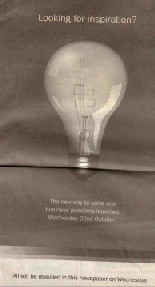
Title of page: Looking for inspiration?
See
cartoon panel
It is the role of Environmental
Education to communicate most truly the true nature of energy.
*********************
My general hypothesis is that if serious
research is performed it will indicate that our current use of symbols
is profoundly flawed and they tend to promote images that generate
maladaptive responses. As an aside, if these
hypotheses are supported then there is a corollary question that might
interest the NZAEE: Is the Environmental Education Industry currently a
major block to sustainable development?
Key
Hypotheses
- Little
science: communication of the nature of energy.
- No
science: communication of how our climate works.
- The
PR industry =dominant determinant of symbol use (curriculum
frameworks).
- You
can avoid Energy Gobbledygook, Greenwash & Spin
- Smart”
solar & electricity use =the future
Communication of the nature
of energy.
I can find no serious research
of the aggregate impact of the different uses of the energy symbol by
scientists, “energy experts”, education institutions, the
Environmental Education industry and the PR industry. Many of these uses
are completely contradictory. Some define energy as a particular energy
form or fuel. Some confuse
energy conservation (an impossible idea anyway) with energy efficiency.
Communication of how our
climate works.
Again I can find no serious
research of the impact of our use of symbols. Many uses are ambiguous
and contradictory. Greenpeace and the New Zealand Climate Change Office
have done some research but these do not tackle the real issues such as
the relative impact of the use of symbols, especially on energy
efficiency practice. The Potsdam Institute did some very interesting
research into the impact of the movie The Day After Tomorrow.

This failed to support their hypothesis, and that of both Greenpeace and
the New Zealand Green Party too, that the movie would empower people. I
predicted on of Human-induced
Climate Change. These hypotheses were both supported by the Potsdam
research.
The PR industry.
The PR industry is probably the
largest industry on the globe, certainly in terms of resources and
scientific know-how. The formal education industry has extremely limited
resources and impact by comparison. A teacher is lucky to communicate a
message 3 times in 3 ways. PR
can communicate a message thousands of times in dozens of ways. How many
school passageways are adorned year-in year-out with Ronald McDonald
McClick posters?

This poster links
McDonalds with health and safety.
It is promoted in our schools by the NZ Government through the Police
Ministry.
In
particular PR is highly skilled at affecting our primal responses
whereas formal education is relatively limited to affecting our
intellectual response. The PR industry can and does effectively set the
national education curriculum. It is pretty much all-pervasive and the
Environmental Education Industry is traditionally one of its most vital conduits. It does this visibly through leveraging off sponsorship and
invisibly by shaping the flow of funds away from “unhelpful”
education programmes.
Avoidance of Spin etc.
There are very simple strategies
that require only your careful use of symbols. The beauty of these
strategies is that they also promote quality science. More on this
later.
The Future
In brief: mining the earth, the
oceans and atmosphere is not future. This includes uranium mining. The
future of our civilisation depends on the conservation of our solar
generation capacity and smart uses of all forms of electricity. These
two strategies are profoundly linked.
It is perhaps helpful to
understand some of the psychology I base my exploration on. You may not
subscribe to it but please be patient and see what it reveals.
Psychology of Communication –
7 Key points
- We
are our images
- Consciousness
= trace element of our being.
- Primal
Responses dominate
- Power
of symbols –reflect our deep conditioning
- In
importance: Mentioned = Omitted.
- The
invisible reveals the visible.
- Environmental
Education = the communication of compassion.
Images
This term is often used to
describe pictures as in photos, graphics, cartoons and other visual
media. I am using its deeper meaning. It is the sum experience of all
our senses and emotional associations. For instance, we can generate an
image using any of our senses as in this case of a greenhouse.
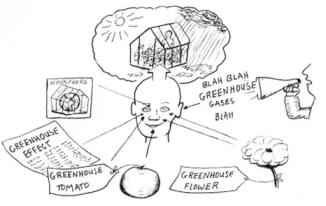
The
experience of the greenhouse will be the sum of all the associations
ever made with a greenhouse. For one person the dominant sense may be of
peace and serenity based on experiences in greenhouses in wet windy
climates. For another the dominant sense is of anxiety if they had bad
experiences growing commercial hothouse tomatoes. For another it might
be a sense of luxury if they associate it with prolific growth and
strong smelling earth.
In that moment of experience we
become and live that sense. We are the image. That sense largely
determines our response to the symbol.
Consciousness = trace element
I will enlarge on this later and
restrict myself to saying we are much more than we are consciously aware
of in any moment. We are an immense ocean of subconscious knowledge and
wisdom and our conscious will is a single sparkle on all the waves of
the sea. Sounds deep? Well it is. The illustrations I use are
two-dimensional. Three and even more dimensions would be more helpful.
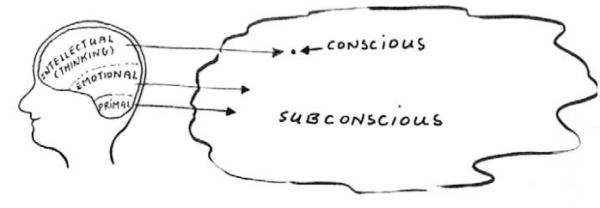
Some become alarmed at the
thought of such profound subliminal activity. I will simply remind you
that you would not be here if this deeper knowledge and wisdom had not
sustained humanity this last million years.
Two corollaries to this are
(1)
Measure the walk rather than the talk
–it is what a person does that tells the real story. That is
especially true of the impact of an educator’s walk.
(2)
Our
use of symbols reflects our dominant primal being. Our choice of symbol
or metaphor is neither accidental nor a matter of simple convenience. It
is driven by a profound if largely subliminal rationale.
Check out recent RMI
research on brains responses to advertisements. RMI is
still a deceptively poor pyschology measure but these results give
us an idea of how
the brain can be experiencing the opposite to what a person says
We are Trace Beings.
The electrons that make us are
trace moments of actuality in a vast ocean of possibilities. The atoms
that make us are almost entirely space. Trace elements of our gene code
differentiate us. “Trace gases” sustain the thermal balance of Earth
that enables us. We are trace elements of the universe. Our beings
consist of a vast psychology in which any moment of consciousness is a
trace element.
We must begin teaching from
Level I in our schools the concepts of tiny fractions and leverage if we
are to understand our Trace Beings and climate processes in particular.
This can start with activities as simple as counting a thousand grains
of sand or beans or trying to count to a thousand in bed at night.
This knowledge is vital in
understanding risk analysis, one of the key components of Environmental
Education.
As an aside, it also has great
value in communicating exponential processes such as compound interest
on bank loans. Then students can understand how a 200 grand mortgage
cost 540 grand in interest over thirty years at current rates
Note: Search Google
Images
of leverage and nearly all the illustrations involve finance
companies.
Primal Responses dominate.
In any moment our conscious response is only one of millions of
subconscious responses to our environment and the changes of the energy
flux we inhabit. It takes great humility to acknowledge this fact for it
does seem to challenge our sense of “free will”. However those who
do enjoy the humility required are better placed to trust and act on the
great wisdom that resides in each of us. The paradox is we then know a
greater sense of freedom.
The power of symbols.
A symbol can take almost any
form – word (written, spoken,) picture, sound, smell, you name it.
Think of two sticks marked in the form of a cross. They can evoke
profound associations with death, grief, love, God incarnate… Symbols
reside within symbols too. For instance, individual words are each
symbols and the way they are laid out on a page form greater symbols
that can completely alter our response to the smaller symbol.
Life
Life
Life Life
Life
Life
Life
Life
LifeLifeLifeLifeLifeLifeLifeLifeLifeLifeLifeLifeLifeLifeLifeLifeLifeLife
Life
As the great profit of the
electronic age, Marshal McCluhan put it over 40 years ago, “The Medium
is the Message”. This is a complex idea and has enormous implications
for Environmental Educators who engage with sponsorship and the
commercial media.
When we use a symbol and how we
respond to a symbol reflects our state of being. We often hear people,
particularly educators and journalists, excuse and dismiss their use of
a symbol as “just a word” or “just a metaphor” or “ just a
symbol”. This is a denial
of the reality that our use of and response to a symbol is determined by
fundamental primal beliefs. In many ways it reveals a lack of love and
of science. If we fail to understand the power of our primal beings in
ourselves we cannot understand how others respond to the symbol use
either.
Mentioned = Omitted.
A fundamental skill in learning
drawing is to be able to see the negative and positive space. In this
case I have drawn all the space, which is not the chair and the symbol
of the chair emerged from it. I looked and drew the spaces between the
rungs and legs, not the rungs and legs themselves. What is wonderful
about this is that we end up with a drawing that more represents the
chair than if I had concentrated only on the rungs and legs. It is more
truthful.
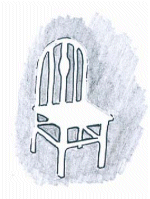
The PR industry understands this
well and it is highly skilled at manipulating the positive and negative
spaces of our consciousness. For instance fossil fuel companies like NGC
and PowerCo call themselves energy companies thus omitting the air out
of the energy equation. They invest in “goodwill” by sponsoring
local orchestras and forest reserves to obscure their impact on the
greater and invisible thermal balances of the atmosphere.
Click
here to see a cartoon sequence of five-panels
offering commentary on lack of chimneys on thermal
plant and bottom less lakes on hydro-electricity plant in Genesis
Energy's education module The initial thermal plant had no
chimney at all
That is why the oil sector and
SUV devotees loved the Auckland Regional Council “Dob in a Smoker”
programme. Removing visible pollution masks the far greater invisible
pollution. Enviroschools is a classic case – it is sponsored by the
New Zealand Government which in turn is driven by commercial imperatives
that can loosely be summed up in its Clean Green
Image strategy
(not, as you will be aware, the Clean Green Practice) and making money
from carbon trading.
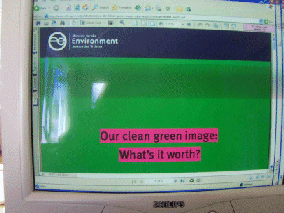
Anyone who has seriously
attempted to promote climate education research, has studied the carbon
emission, truck and SUV use or transport investment statistics or has
sat in on Climate Change Office briefings to the business sector or who
has read the Minister of Energy Peter Hodgson’s press releases, as I have, will know the
Government promotes carbon trading as a useful source of income because
of our “good fortune” in having existing forest sinks. The recent
Fart Tax, Carbon Trading and Carbon emissions fiascos (An
estimated $500 million surplus suddenly became a $500 million
deficit) were predictable
and avoidable. As was the Christmas announcement the New Zealand
Parliament is scrapping the long planned Carbon Tax.
It
is no mistake that Enviroschools does not have a significant
energy-climate component.
Class Learning and Action
Learning and action is organised
around 5 themes:
•Living Landscapes
•Ecological Buildings
•Healthy Water
•Precious Energy
•Zero Waste
I doubt it would have got funding if it had.
What was its role in these fiascos?
It is also no mistake the Government refused to fund the Energy
Action 2008 programme, which works to reveal the real impact of
New Zealand ’s activities on the atmosphere.
The invisible reveals the
visible.
This is a corollary to the above
discussion on omission. Few skills are required to teach the visible.
Greater skills are required to teach the invisible. Our Trace Beings,
our Thermal Beings (we cannot see heat) and the air that sustains us are
all largely invisible. Focusing on the development of skills that
promotes awareness of these invisible milieus will provide the skills
and more that enable us to teach the visible.
Because our intellects and the formal education system tend to
focus on the visible the reverse is not true.
Compassion
The Principle of Uncertainty,
one of the great principles underpinning ancient psychologies like
Buddhism and modern ones like quantum physics, says that our very act
of observation alters the observed. We cannot be an impartial observer.
This is something many Scientists have difficulty coming to grips with.
I recommend the movie “What the Bleep do we Know?!” as an
interesting exploration of the implications of this.
I draw from this the belief that
while we are part of creation we can never truly know what good comes
from bad.
It also suggests that your view
is equally is vital and valid as my view of an object. The truth lies
somewhere in the summation of all our views. I draw from this the need
and value of tolerance. All points of view count and we can learn from
them all. There is nothing new in this concept – sages through the
ages have attempted to communicate it to every civilisation.
The fact we can never truly know
good from bad does not leave us immune to the consequences of our
choices. No. We need constantly be aware of the balances of environment
that sustain us and we ignore them at our cruel peril. So how do we
transcend our ignorance, our “human condition”? In the message of
tolerance I speak of we find compassion. Compassion enables us to learn
from our mistakes, to communicate to others so they feel acceptance and
to care for the natural world.
General
Concept
Psychology
Continuum: Science < - > PR
Science.......................................................PR
Inclusive
Exclusive
Openness
Limitation
Trust
Doubt
Collegiality
Fear
The
qualities and emotions listed under Science tend to generate bonus
joules. The qualities and emotions listed under PR tend to
generate junk joules.

This
PR example displays all the qualities listed above. The man is alone,
alienated by his hair. The original ad had woman lying beside his hairy
body. Her face and body language expressed total revulsion of him.
I will now apply this summary
thinking to the great symbols that underpin civilisation, agriculture
and Environmental Education
Energy
symbol
·
One of most potent
symbols.
The only symbols that have comparative power are love, sex, life,
God and, of course, power. They express our
capacity to exist at the most profound level and are often used
interchangeably eg God is life. Love is bounteous as energy. Etc
·
Underpins all human activity.
The energy symbol underpins all our awareness of religion, science,
politics, civilisation and Environmental Education.
·
Hard to define:
Stuff or potential or capacity that “enables” universe. “The
ability to do work” "the
ability for action"
·
Flawed images => extinction of
civilisation
From the Mayas to the Minoans to the Mesopotamians to the Greeks to the
Easter Islanders, civilisations have treated trees and soils as though
they were as bounteous as the universe and as a result their
civilisations were reduced to miserable remnants as the resource
disappeared.
·
Recent redefinition by industrial
sector.
The last thirty years have seen a redefinition or imagineering of the
energy
symbol by banking interests/industrial sectors. The movies Enron:
The Smartest Guys in the Room and The Corporation
offer valuable insight into how these sectors work. Wikpedia puts it
kindly when it discusses the business definition of
energy. This says
energy
“may also be used in economics to describe
the part of the
market where energy itself is
harnessed and sold to consumers.”
A less
kind description is that this wonderful symbol has been expropriated by
greed-driven merchants who wish to use fossil fuels and sell
Bulk-electricity regardless of the consequences to the environment or
our children. Put simply, modern economics is not founded in the reality
that we ignore natural balances at our peril.
See three panels of cartoons the
exploring history of the
imagineering of energy symbol.
·
Conservation Principle = near as we
have to a natural law.
The Principle states that
energy remains constant though it is constantly transformed. It cannot
be created or destroyed and is by its very nature renewed. Humans have
dreamed since time immemorial of discovering forms with the bounteous
properties of energy. There are always people claiming to have created
perpetual motion machines, elixirs of youth, eternal health medicines
and sources of Renewable Energy. Often the latter are merchants of large
wind mills, huge hydro dams and ethanol cars – all ultimately
unsustainable investments.
The truth is there is not one single authenticated account of any human
ever breeching the Principle of Conservation. Modern corporations that
attempt to describe a fossil fuel or Bulk-electricity as energy are
simply liars, con artists and charlatans. Their activities are made all
the more dangerous because calling a fuel energy
eliminates air out of the equation and puts us all at risk of
catastrophic human-induced climate change. See the Genesis example
of omission above.
·
Fatal confusion: Energy = energy
form
Our confusion of energy with energy forms is fatal, for all energy forms
are relatively very limited and the day an energy form is energy is the
day when the universe does not exist. As mentioned, past civilisations
have treated trees or the soil as though they are as bounteous as
energy. Within a period of a few centuries they destroyed the forests
and/or salinated rich soils beyond use for tens of thousands of years.
·
Fatal confusion: Energy =Energy Use
The PR industry promotes and exploits this confusion. For example, note
how we have an “energy crisis” when hydro-lakes run low. Spin
merchants for the Bulk-electricity-Fossil fuel sector manipulate our
most primal emotions of fear so they can organise our behaviour within
carefully prescribed frameworks. These
maintain powerful associations with their product so it is seen as vital
to our existence. In doing so they obscure alternatives such as
long-term energy efficiency options. As soon as lake levels rise again
the “energy crisis” evaporates. Note: they do not talk of energy use
crises, less still of Bulk-electricity use crises.
Suggestion
(1)
Talking energy form? Name energy form(s).
(2)
Talking energy use? Use word use.
(3)
Talking crisis? Use crisis of use.
Power
symbol
- One
of most potent symbols.
As mentioned this is one of important symbols. Like energy
we talk of Power of the Almighty, Power of Love etc
-
- Symbol
underpins all human activity
- religion, science, politics,
civilisation, Environmental Education
-
- Definition
Energy divided by time. Joules per second
- Redefined
by Merchant Bankers
The symbol is a major casualty of a century long war starting in
the 1890’s by omni-powerful bankers like JP Morgan to gain power
of the global economy using Bulk-electricity. {See
Empires of Light : Edison,
Tesla, Westinghouse, and the Race to Electrify the World (Hardcover
by Jill Jonnes and Power
Play by Sharon Beder: The Fight to Control the World's
Electricity.)
Initially the fight
was between Alternating Current and Direct Current proponents with
Edison
promoting the use of the electric death chair to show how dangerous
AC is. These people are ruthless. Once this battle was over (AC won
because it has the capacity to be a long distance carrier of energy)
the fight became to ensure Bulk-electricity use dominated at the
expense of small-scale “distributed generation” (DG) options.
The returns for the bankers are far higher from Bulk-electricity
investments than from small scale electricity generation at point of
use.
At present these bankers are very successful and dominate our
perceptions of our options – with the considerable help of
teachers and Environmental Educators. Think of how many education
resources talk of Powerswitch, powerplay, power pole, power bill,
power socket, power station, powerman, powerboard, powerline, etc.
Every time the Power symbol is used this way it rings
bells for the merchant bankers and obscures potential uses of other
wonderful electricity forms.
The use of the symbol in powerline is particularly unhelpful
because the wires are also communication lines and have been so for
50 years. How many people know that? Local
grid operators have long been able to “talk” to and
operate switches in your dwelling. The utility poles have always
carried the copper telephone cables and now carry optic fibre too.
It is now possible to transmit broadband down the so-called
electricity wires and the bankers are now fighting a largely secret
battle to gain control of this medium as well as ensuring broadband
capacity is not used to affect their profits from fossil
fuel/Bulk-electricity sales. The current transfer of control of Vector
Ltd from community ownership to a couple of overseas
merchant bankers continues this trend. All this has vast implications for our
impact on the environment.
Suggestion
(1)
Talking electricity? Do NOT use Power
symbol. (Electricity is only one form of power.)
(2)
Know electricity comes in many
forms.
Name the form you are referring to eg static, Bulk-generated,
distributed generation, alternating current, direct current,
Bioelectricity piezoelectricity, triboelectricity, thermoelectricity,
atmospheric electricity, etc
(3)
Understand electricity
is a field of science.
climate change
symbol
- Great
constant in our life.
- Symbol:
normal association = positive feelings.
Think how you feel if
the climate does not change – we soon begin to feel sensations of
fear, concern, worry, dread. We know in our deepest cells of our being
that change is the natural order just as energy is a flux of forms. The
song turn turn turn resonates from biblical times and before
To
every thing, turn, turn, turn, there is a season, turn, turn, turn,
and a time to every purpose under heaven.
A time to be born, a time to die, a time to plant, a time to reap.
A time to kill, a time to heal, a time to laugh, a time to weep.
- Popular
use= ambiguous >>> meaningless.
While Environmental Educators may be attempting to communicate a
negative or threatening situation because of, for instance, say gas
emissions from human activities, people at a primal level are
registering sensations of security and normalcy.
- Requires
caveats i.e. type of climate change.
Suggestion:
talking climate change?
(1)
State type eg seasonal change, solar
driven change, Human-induced change...
(2)
Use alternative symbols eg Thermal
Imbalance, human pollution
global warming
symbol
- Essential
for life on Earth.
The continual warming of the globe is an essential process.
- Symbol:
normal association = positive feelings.
Every cell in every
creature or plant senses and responds to sunrise in some way or
another. Hands up anyone who does no believe the daily warming of
the globe is not a good thing for them.
Links to web examples illustrating global warming is a perfectly natural,
welcome, and healthy experience: 1.
2.
3. (Warning:
Use of the lesson activities at this website is very high risk -NOT
RECOMMENDED. Serious research would probably indicate that
their use will undermine science and strategies for mitigating
human's impact on the thermal balances that sustain us.) 4.
- Popular
use= ambiguous >>> meaningless.
See climate change above. Also there is a profoundly different
response to warming (the
temperature remains constant)) v warming UP (. The temperature
rises.) These are two very different processes and experiences.
- Unhelpful
symbol for Human-Induced Climate Change.
It removes the human element out of the equation and the fact that
it is our activities that are the issue.
- Increased
thermal build-up >> local coolings.
The effects and experience are not global. Examples are potential
thermohalene circulation collapse on Europe
and increased snowfalls in centre of the Antarctic. The severe
cold of the 2006 winter in Europe is balanced by warmer than average
weather in the American continent.
Suggestion:
Talking human impact on Earth's thermal balances
(1)
Use symbol such as
Global Thermal Imbalance
(2)
Talking warming up/ cooling down? Say
warming up/cooling down.
Greenhouse
symbol of atmosphere (general)
- Symbol
use pervasive in Anglo US culture
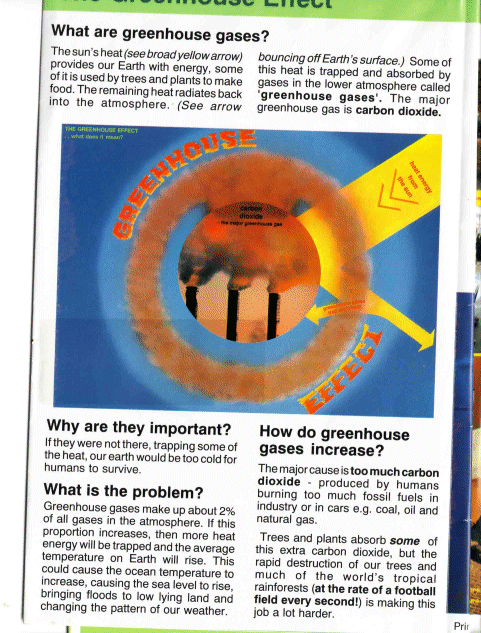
This Greenpeace page evokes images of Earth's
atmosphere no less than 10 times.
Note: Water Vapour, not carbon dioxide, is by far the most dominant
Warmer Trace Gas. It is our prime experience of weather and without its
presence Earth's surface would be 20C cooler than its current 15C.
- Powerful
PR tool.
The Symbol green evokes very positive associations. It is no mistake
a most powerful (there’s that symbol again), a most powerful lobby
is The Greening
Earth Society. This is a “ public relations organization founded, funded, and controlled by the
Western Fuels Association, an alliance of coal-burning utility
companies.”
- Origin
– Fourier 1820s.
Fourier, the great mathematician, developed the greenhouse metaphor
after experiencing the extreme thermal variations of the Sahara
as a young man. At a time when the existence of gases was barely
known it was an extraordinary leap in cognition of atmospheric
processes.
- Associations
= man’s dominance over nature.
The Industrial Age coincided with the greenhouse becoming a great
symbol of prestige as it enabled wealthy Europeans to grow tropical
fruits such as the pine apple.

http://www.placeaudesign.com/reperes/histoiredudesign/palace.jpg
The great Crystal Palace of Great Exhibition 1851 had a huge impact
on Western sensibility – as it was designed to. It glorified
Britain ’s engineering capacity and military might. Sermons of the time
used it to proclaim the might and dominion of Man over nature and to
glorify our powers.
- Mechanistic
(inorganic & static) world-view.
The use of the term cannot but evoke images of human structures. We
end up with the impossible situation where Environmental Education
resources (e.g. Friends of the Earth) show pictures of a greenhouse
so they can remind us that the atmosphere does not work like one.
- Primal
associations= shelter, control,
calm.
You can understand why the PR industry finds this use of the symbol
invaluable. It rings all the right bells required for obscuring key
knowledge and a sense of need for change. This may vary with
tropical and temperate regions – anecdotal evidence is that it may
have less comforting associations in the former.
- Promotes
unhelpful learning activities.
Traditionally these involve experiences based on bottles,
greenhouses and sealed cars in the sun. These do not promote
“trace” and energy transformation activities.
- In
summary: a very poor use of the greenhouse symbol. http://www.ems.psu.edu/~fraser/Bad/BadGreenhouse.html
Greenhouse
symbol of atmosphere (specific flaws)
- Obscures
great energy transformations.
It is essential to understand that the
bulk of the heat in the atmosphere is radiated from earth’s
surface in the form of infrared waves and the atmosphere warms
Earth’s surface more than the sun does.
- Obscures
gas transformations
Example – the constant destruction and creation of ozone from
solar activity. These involve truly extraordinary and massive
vertical movements or pulsings of hundreds of kilometres of the
atmosphere daily.

- Obscures
convection & conduction properties.
It is the ability of the atmosphere to facilitate convection that
enables life on Earth i.e. the fact that it does not act like a
blanket. Blankets suppress air convection. We are better to see the
atmosphere as warmed rivers of air flowing around the planet if we
are to know the dynamics of our climate. We cannot simply open a
vent and let excess heated air flow out as we do in a greenhouse.
- Obscures
fluxing layers of gases & heat.
Unlike a greenhouse the atmosphere consists of many heat layers of
heat
Greenhouse
symbol of insulation (dwelling, clothing and transport)
- Best
use of symbol
- Greenhouse
= suppress air convection.
- Air
=facilitates thermal convection
- Air
= poor at thermal conduction
- Best
use of Blanket symbol.
Understanding how
insulation works is essential for energy efficient practice in
maintaining our personal comfort levels using clothing and buildings and
minimising our negative impact on the environment.
Suggestion
– Think major, long-term decision makers = builders/plumbers/
electricians.

Chapter 3 contains a sequence exploring
some current practices of tradespeople.
Trace (gas)
- Traditional
definition: barely detectable.
Before modern technology it was very
difficult to detect and measure gases that exist in only a few parts
per thousand of the atmosphere. Their presence was detectable but no
more.
- Current
definition: relatively minute (<1%)
Modern technology means we can detect
gases that are a few parts in a million of the atmosphere. 99.9% of
the atmosphere consists of just three gases – oxygen, nitrogen and
argon. All the other gases exist in parts per thousand or less and
are called Trace Gases. This includes water vapour, which varies
from mainly 0% to 4% in a few small highly localised areas.
- Warmer
Gases = trace gases
Some of the trace gas have a
relatively high capacity to retain thermal energy in the form of
infrared waves. They act as warmers and are warmer. Without them our
planet’s surface would average 33°C
cooler i.e. the Earth would lack life as we know it
- Trace
concept >> study of tiny
portions, leverage & risk
analysis.
Teach trace theory is very different
to teaching greenhouse theory. The focus is on lesson activities
that developing a clear sense of large numbers and tiny proportions
and on appreciating the power of leverage. This links later to the
teaching of risk analysis in mitigating our impact on the
environment.
- We
are Trace Beings
As I mentioned earlier we lead trace
existences. We need embrace this if we are to know ourselves and
lead sustainable lives.
Suggestion
re Trace Gas
Talking
thermal balances of atmosphere? Talk Warmer Trace Gases ( NOT greenhouse
gases). They are warmer than the most common gases such as oxygen,
nitrogen and argon and, unlike them, they also act as significant
warmers.
Now we get to the point of how
to evaluate and communicate the impact of our activities. This is the
study symbolised by energy efficiency. It is not to be
confused with energy conservation- an impossible and most
unhelpful concept (energy is conserved by its very nature).
My own general definition of energy efficiency is the continuous
generation of bonusjoules. Note the emphasis on the word continuous.
Energy efficiency (General)
- Every
act = choice of energy USE.
Energy comes in many forms and in any
moment we have a range of choices how we use those forms, be it
sitting in the sun or turning a heater on to keep warm.
- Energy
efficiency = measure of relative impact on resources.
Every use has an impact on the
environmental/thermal balances that sustain us and the impacts vary
by the moment. Hence it is always a relative measure.

Link to cartoon panel exploration
- Does
not mean using less energy
Contrary to what the Government
teaches in our schools through agencies like the Climate Change
Office and EECA, it does not mean using less energy – or more
energy for that matter. Note: Governments and Bulk-electricity
bankers exploit the "energy conservation" symbol to
reduce public perceptions of energy for revenue reasons. In
particular they combine the flawed construct of "energy
conservation" with "energy crises" to manipulate
consumer behaviour.
- Involves
best use of energy forms
A simple example is you can use a lot
more energy by designing your home so you can make use of solar
energy. You are using more energy without negatively impacting on
the thermal balances that sustain us.
Energy efficiency (measures)
- negawatts
(Rocky Mountain Institute)
This concept was created by Amory Lovins of the renowned “energy
efficiency” institute. Fundamentally, he was attempting to put a
tradable economic value on a non-taxed use of energy e.g. putting on
a coat to keep warm rather than turning on an electric heater. The
KiloWatt hours of Bulk-electricity not used are measured and valued
in terms of say the money not required to build generating plant and
grids to meet the extra demand for Bulk-electricity.

Link to cartoon panel exploration
- negawatts
flaws
= negative, exclusive, time-bound.
People associate nega
with negative i.e. undesirable. Most people associate
Watts
with the measurement of Bulk-electricity. My experience working for
an energy efficiency firm called Negawatt Resources Ltd is that the
symbol rings all the bells for Bulk-electricity sector and focuses
attention on the power point as the major source of
useful energy and not the sun. People have difficulty associating
the symbol with the positive practice of energy efficiency.
Negawatts is time bound in that it does not link to
subsequent impacts. For example, you might save money installing
energy efficient light bulbs but if you then go and spend that money
flying to a conference overseas then the environment is measurably
worse off – even if it is a conference to save the environment.
California attempted to incorporate negawatts into their electricity market.
Ruthless Bulk-electricity companies conveniently had to schedule
“shut downs” of their generation plant for “maintenance” at
crucial times. They then ordered electricity over networks that
would be overloaded by their order and were paid $ US millions daily for not using electricity that they never had any
intention of using anyway. The rest is history and now we have Arnie
to ensure that the State does not attempt to sue and retrieve the
$US9billion from the likes of Enron as Governor Grey Davis attempted
to do.
- bonusjoules
–associations>> affirmative, universal
I developed this symbol as people
associate the bonus symbol with positive outcomes and joules
is a more universal definition of energy. It is a common measure
that is found on all consumables, including drink and food. This is
important as food and drink are absolutely vital and yet are not
commonly viewed as “energy” or fuels as say coal is. Of course
in all these cases the joules of energy are only available when the
fuel is combined with air – something no advertiser points out.
- Bonusjoules
= long-term, low-risk considerations.
Put simply it involves thinking about
how our activities will impact on our children
- Bonusjoules
flaw = time-bound.
This has the same flaw as negawatts.
- Energy
= flux of constant transformations.
As discussed earlier, that which can
be perceived as a better use of energy one moment can be perceived
as a worse use of energy in the next moment.
- Junkjoules
= short-term, high-risk considerations
Put simply the welfare of fellow
humans and environment are considered of little consequence
- Bonus
& Junk = Language of Economics
Like Amory I am attempting to provide
a language so people’s perceptions of a healthy economy are
widened. At present the economy is seen to shrink, become ill, fail,
etc if you turn off the Bulk-electricity powered heater and sit in
the sun to keep warm. Economics uses the symbols in terms like Bonus
Bonds, bonus remuneration bonus shares… and junk bonds, junk
status….
- Bonusjoules-junkjoules
= twin complementary, co-evolving concepts. One
cannot be considered without the other. As mentioned, that which can
be seen as an efficient use of energy one day may be seen as an
inefficient use the next day as information and technology evolves.
-
EE=Yin
Yang in circle of compassion.
I talked earlier of the role of
compassion from the great Uncertainty Principle. For us to be able
to truly be open and honest about the impact our use of a form of
energy we must be able constantly admit that what previously
generated bonusjoules now may generate junkjoules. 
-
Compassion means
it is not a black versus white issue as the Yin Yang symbol is
often portrayed.
The yin can be seen as tendency to openness and
inclusiveness and the yang a tendency to secrecy and exclusiveness
(or vice versa).
There is nothing new in this idea and it bears telling in every
conceivable way.
Origins of ying yang symbol
Suggestion:
Talking Energy Efficiency? Talk generating bonusjoules and junkjoules.
As Environmental Educators you
may be interested in my proposals for evaluating the use of resources. I
have provided the example of possible considerations about the siting of
the proposed Aquarium of New Zealand on the coast just below my home. It
can be viewed at www.bonusjoules.co.nz
5 Step analysis of Energy Use
of an Environmental Education Resource.
1)
Planning and construction
2)
Maintenance and Deconstruction
3)
Communication costs
4)
Design impact
5)
Sponsorship leverage
Additional note: The energy
impacts of 1 and 2 have long been calculated and now some engineers are
beginning to calculate 3. In some cases they find that the extra energy
used by a building sited a distance from mass public transport compared
to its siting adjacent to it can be twice that of 1 and 2.
4 and 5 are more difficult to
calculate though they well have the largest impact. An example of 4 is
The Warehouse with its large centralising carparks. Examples of 5 are
the Government’s Clean Green Image Programme and the Consumer
Institute’s PowerSwitch. The
impact of 1,2 and 3 for the latter may be minimal. However the use of it
by the Government to promote the interests of the bankers of our
privatised model of Bulk-electricity distribution means its impact is in
the order of gigajoules of energy. It works directly against energy
efficiency and Distributed Generation principles.
The Post Cheap Oil-Gas Age
- Oil
and Gas reserves are pretty much at their peak.
In brief, about 2 billion humans have used up half the reserves on
planet Earth in two generations. The growth in consumption (a bell
curve up) is mirrored by a growth in the human population from 1.5
million to 6.5 billion. From now on it will cost more to extract
every barrel and there will be greater demand for every drop.
Already oil-addicted countries such as New Zealand are experiencing the related inflation and loss of wealth as oil-Gas
prices rise.

- Oil
and Gas underpin our present food and health systems.
- We
forget this at our peril. A century ago all the calories required to
put a calorie of food on the average plate of a human came from the
sun. Now five out of every six of those calories come from oil. A
barrel of oil (42 gallons) provides the equivalent of 25,000
man/woman hours of labour
- Countries
dependent on the use of oil and Gas >increasing risk.
- Electricity
use = key to survival of civilisation/environment conservation.
This is because it can provide with optimal efficiency the
communication and transport systems that underpin any substantial
civilisation.
- Must
teach about PLC, DG and smart metering/response systems.
As mentioned earlier our use of electricity is at present controlled
by bankers of the Bulk-electricity/fossil fuel sector. This involves
immense waste and is very high risk. This is a whole topic in itself
and one that every Environmental Educator should know about. In
brief we are at the confluence of three great new technologies:
(1) Broadband over the
utility lines and out of every socket in the dwelling;
(2) Small scale
electricity generation at the point of use eg using gas fired
central heating plant, photovoltaics and vertical wind turbines;
(3) “Smart”
electronic systems so household items can respond to fluctuations in
Bulk-electricity demand and thus reduce the need to dam rivers, burn
fossil fuels and crowd out the countryside with large wind turbines.
The scale of the ignorance of this confluence is revealed by the
complete lack of cognisance and opposition of the New Zealand
Environmental Education Industry to the recent sale of Vector Ltd.
Our failure to educate for this confluence will have a
massive negative impact on the environment.
"Meterboard”
= A major key to survival.

The individuals that control your meterboard also controls how you
design your dwelling, how you use your dwelling, what appliances you use
and what bulk demand you place on the environment. It is a huge switch
in our lives. It can turn us on or off to Distributed Generation and can
dictate whether we can talk to the grid or only listen. It can switch
off life to huge tracts of forest. It can switch on a massive emission
of Warmer Trace Gases.
At present this switch is largely controlled by one company - Vector
Ltd. Its recent acquisition of NGC alone gave it significant control of
half the design and use of dwellings in New Zealand – over 880,000 dwellings. As I talk the control of Vector is being
transferred into the hands of a couple of overseas merchant bankers and
they will become the dominant environmental educators and arbiters of
the nation. You used to own your meterboard once as part of your
membership of one of 60 democratically elected community structures in
New Zealand .
We have to start teaching the power of the meterboard again so people
can catch a glimmering of what is going on. All your other work will be
in vain until that happens. You can teach your hearts out but you will
find the environment disintegrating around you.
Chapter
seven part 2 of Bonus Joules and the Knowledge Economy features
a cartoon exploration of our current Bulk-electricity system. It
identifies blocks to an intelligent system and suggests sustainable
options

Summary
Strategies for avoiding
Energy
Gobbledygook, PR Spin and for promoting science.
- Know
how symbols shape civilisation
- Measure
the impact of symbol use by the walk, not the talk
- Say
what you mean even if it takes an extra word.
- Know
the
Principle of Conservation of Energy is upheld so far
- Energy
forms and fuels are not energy. Always name the form.
- Bulk-electricity
is not power. Always name the type of electricity.
- Talking
climate change, state the type of climate change eg. Human-induced
Climate Change
- Avoid
symbol global warming. Use Thermal Build-up etc
- Focus
on behaviour, not on resource/matter
- Use
Use. E.g. Bulk-electricity use crisis,
- Know
compassion – for the self, for others and for the environment.
- Check
out the Energy Gobbledygook section,
the Bonus Joules cartoon and
the Alternative Climate Education
sections for supplementary
support.
All
at www.bonusjoules.co.nz
Return
to Electric Thinking
Return
to Update Page
Return
to the Welcome Page

Acknowledgements
The Bonus Joules website
could not have occurred without the incredible support of Rene Duindam,
Claudia Schotz and their family. They provided a roof over my head for
over two years and enabled me to survive on less than the minimum dole.
The website is constructed on their computer which is based in their
bedroom and they have tolerated my presence there for thousands of
hours. Rene is always available with the vital support and advice
required to construct and maintain a website on this scale. Always they
have believed in my work.
Thanks to Mandy Hager
and family who provided me with scanning and copying facilities and
support for my work too.
Special
thanks too to Chris Arcus, my ex-tutor from Wellington College of
Education 1998, who has consistently taken time out to read my work and
encourage my development.
References
Potsdam
http://www.nature.com/news/2004/040830/pf/431004a_pf.html
http://www.pik-potsdam.de/pik_web/publications/pik_reports/reports
A few PR Industry examples
http://www.projectcrimson.org.nz/WSMApage/0,1567,15645-0,00.html
http://www.comalco.com/freedom.aspx?pid=304
http://www.comalco.com/freedom.aspx?pid=720
http://www.yellow-eyedpenguin.org.nz/supporting/index.html#major
http://www.positive-energy.co.nz/positive-energy/
http://www.mightyriverpower.co.nz/community/
http://www.meridianenergy.co.nz/forms/results.aspx?text=sponsorship&HotLinksList=%23&x=16&y=13
http://www.aa.co.nz/Org?Action=View&Org_id=26
http://www.vectornetworks.co.nz/company_profile/community.php
http://www.powerco.co.nz/G_P_V/Community/h_homes.htm
http://www.powerco.co.nz/G_P_V/Community/eda.htm
http://www.eeca.govt.nz/search/?q=sponsors&x=22&y=12
http://www.transpower.co.nz/?id=5751
http://www.rsnz.org/members/#Sponsor
http://www.mcdonalds.co.nz/community.htm
http://www.mitre10.co.nz/
http://www.bunnings.com.au/site/awdepfour.asp?q=0&dealer=5709&depnum=8570
Marshal McCluhan
http://www.mcluhan.utoronto.ca/article_mediumisthemessage.htm
Genesis Energy education module
http://genesisenergy.co.nz/
Enviroschools
http://www.enviroschools.org.nz/index.php
Clean Green Image
http://www.mfe.govt.nz/publications/sus-dev/clean-green-image-value-aug01/
http://www.mfe.govt.nz/publications/sus-dev/clean-green-image-value-aug01/chapter-7-aug01.pdf
National carbon deficit
http://www.climatechange.govt.nz/policy-initiatives/policy-review/
What the Bleep do we Know?!”
http://www.whatthebleep.com/
Enron movie
http://www.enronmovie.com/
The Corporation movie
http://www.thecorporation.com/
Wiki definition of energy
http://simple.wikipedia.org/wiki/Energy
Sample of Civilisation collapses
http://www.rainbowbody.net/Finalempire/
http://science.nasa.gov/headlines/y2004/15nov_maya.htm
http://www.crf-usa.org/bria/bria18_4a.htm
http://www.radford.edu/~wkovarik/envhist/1ancient.html
History of the Bulk-electricity
sector
http://print.google.co.nz/print?id=uRugcsXFSvYC&dq=cities+of+light+history+electricity+book&oi=print&pg=PR13&sig=o1B8_sc3WOYp_9laLS3tykyo3d0&prev=http://www.google.co.nz/search%3Fhl%3Den%26q%3Dcities%2Bof%2Blight%2Bhistory%2Belectricity%2Bbook%26btnG%3DSearch%26meta%3D
Power Play by Sharon
Beder
http://www.ccadp.org/electricchair.htm
What is electricity?
http://www.amasci.com/miscon/whatis.html
To Everything (Turn, Turn, Turn)
Music
by Pete Seeger The words are adapted from The Bible, Book of
Ecclesiastes.
Thermohaline circulation
http://en.wikipedia.org/wiki/Thermohaline_circulation
Antarctic variations
http://www.nasa.gov/vision/earth/environment/sea_ice.html
http://www.antarcticconnection.com/antarctic/weather/storms.shtml
http://www.sciencedaily.com/releases/2005/06/050630064726.htm
Greening Earth Society
http://en.wikipedia.org/wiki/Greening_Earth_Society
Fourier and greenhouses
http://www.nytimes.com/books/first/c/christianson-greenhouse.html
Crystal Palace of Great
Exhibition 1851 sermons
http://www.victorianweb.org/history/1851/clayton.html
Ionosphere flux
http://en.wikipedia.org/wiki/Ionosphere
Atmosphere: thermal layers
http://liftoff.msfc.nasa.gov/academy/space/atmosphere.html
http://www.srh.weather.gov/srh/jetstream/atmos/layers.htm
Thermal properties of air
http://sol.sci.uop.edu/~jfalward/heattransfer/heattransfer.html
http://en.wikipedia.org/wiki/Atmospheric_circulation
Thermal Insulation
http://www.school-for-champions.com/science/thermalinsulation.htm
http://www.eurima.org/uses/thermal_insulation.html
http://en.wikipedia.org/wiki/Insulation
http://msucares.com/pubs/infosheets/is1618.html
http://www.geocities.com/ResearchTriangle/Facility/8776/Pag02I.htm
http://www.gov.mb.ca/agriculture/crops/greenhouse/bng01s04.html
Trace gases
http://en.wikipedia.org/wiki/Earth's_atmosphere
Atmospheric Thermal Effect
http://www.science.org.au/nova/016/016key.htm
http://www.ems.psu.edu/~fraser/Bad/BadGreenhouse.html
“energy conservation”
http://www.eeca.govt.nz/
http://en.wikipedia.org/wiki/Energy_conservation
Rocky Mountain Institute and negawatts
http://www.rmi.org/
Ideals of California and negawatts
http://www.bizjournals.com/sanjose/stories/2002/06/17/daily27.html
Enron
Pipe Dreams: Greed, Ego, and the Death of Enron:
Book by Robert Bryce
Power Play by Sharon Beder
Ying Yang symbol origins
http://www.chinesefortunecalendar.com/yinyang.htm
Oil and Gas reserves
http://www.peakoil.net/
Sample electricity distributed
generation thinking
http://en.wikipedia.org/wiki/Distributed_generation
http://future.iftf.org/energy/
http://www.worldchanging.com/archives/002152.html
http://www.eurekalert.org/pub_releases/2003-09/teia-seg092203.php
http://www.pewclimate.org/docUploads/10%2D50%5FAnderson%5F120604%5F120713%2Epdf
http://en.wikipedia.org/wiki/Power_line_communication
Vector, NGC and meter ownership
http://ongas.co.nz/article/view/226/1/8
http://www.vectornetworks.co.nz/
Vector and PowerCo
privatisation
http://www.nzherald.co.nz/organisation/story.cfm?o_id=47&ObjectID=10340945
http://www.sec-com.govt.nz/notices/summaries/2004/sr04-245.shtml
http://www.sharechat.co.nz/news/scnews/article.php/7e732c4d
Sunday Star Times
Mfe Climate Change Office
booklets for primary schools 2001.
EECA -EnergyWise
magazines
Power Summit 2005
SCOOP Independent News
Return
to Electric Thinking
Return
to Update Page
Return
to the Welcome Page

|



















